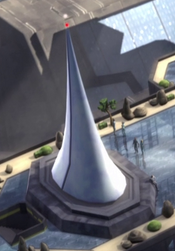| | |
- "A civil war killed most of Satine's people, hence her aversion to violence."
- ―Obi-Wan Kenobi, to Anakin Skywalker on Duchess Satine's pacifism
The Great Clan Wars, also known simply as the Mandalorian Civil War, was a conflict fought between the New Mandalorian peace movement and martial traditionalists for control of the Mandalorian homeworld of Mandalore around the years 41 BBY to 39 BBY. The New Mandalorians won the war and Duchess Satine Kryze became leader of Mandalore. While the group who became regarded as the "Old Mandalorians" were also exiled and left for the greater galaxy, the surviving traditionalists were exiled to the planet's moon of Concordia, where they evolved into the Death Watch.
Prelude[]

The surface of Mandalore was reduced to desert by centuries of war.
The planet Mandalore, homeworld of the Mandalorian people, was once a lush, verdant world. However, centuries of war against enemies internal and external eventually reduced its surface to a featureless desert. Survivors relocated to scattered settlements built around what few remaining sources of potable water remained on Mandalore or retreated to the planet's moon of Concordia, which was also capable of supporting life. Food exports from Concordia helped keep many of those still living on Mandalore alive. The city of Sundari rose up from the desert beneath a massive bio-dome and birthed the New Mandalorians, a peace movement that sought to channel the energies and inventiveness of the Mandalorian people into rebuilding their society along peaceful, creative lines.[6]
They realized that mercenary expertise in warfare had brought no lasting benefits to the majority of Mandalorians and gradually grew in strength to eventually challenge Mandalore's minority of martial traditionalists, who used violence to hold on to power by the time Duchess Satine Kryze led the movement.[6] Between circa 41 BBY and circa 39 BBY,[1] civil war broke out between the two groups for control of Mandalore.[6] This conflict was referred to as the Mandalorian Civil War,[7] and alternatively as the Great Clan Wars.[8]
The war[]
- "Master Qui-Gon and I spent a year on Mandalore, protecting the duchess from insurgents who had threatened her world. They sent bounty hunters after us. We were always on the run, living hand to mouth, never sure what the next day would bring."
- ―Obi-Wan Kenobi
The father of Satine Kryze, Duke Adonai Kryze, was killed during the conflict[8] while defending Mandalore.[9] Due to her status, Jedi Master Qui-Gon Jinn and his Padawan, Obi-Wan Kenobi, spent a year on Mandalore to protect Kryze from the traditionalists, who sent bounty hunters after the trio and forced them to live on the run. Their time together led Kryze and Kenobi to fall in love.[2] Mandalore's already-damaged surface was decimated[10] and the planet's capital of Keldabe was devastated by the fighting.[6]
Aftermath[]
- "When she returned, she took on the difficult task of rebuilding her world alone."
- ―Obi-Wan Kenobi, on Satine Kryze
The death toll during the war became a primary reason for why Kryze was averse to violence, a pacifist belief she held for the rest of her life. At the end of the war, Kenobi chose to return to the Jedi Order, though he would have left had Kryze asked him to. The duchess returned and set about rebuilding Mandalore herself and[2] ruled over Mandalore up to the Clone Wars[11] twenty years later.[6] The surviving traditionalists were exiled to Concordia, where they turned on each other in a pointless battle for dominance[6] and were believed to have died out.[11] Meanwhile, Mandalore was rebuilt and thrived under the leadership of the New Mandalorians, who moved the planet's capital to Sundari, their center of influence.[6]
The so-called "Old Mandalorians," who also worked to keep Mandalore's warrior history alive, were also exiled after the war.[5] A monument to those who died on all sides of the war was built in the city's Peace Park.[6] Retaining governance of Concordia, Mandalore became an active participant in the senate of the Galactic Republic while remaining neutral throughout the Clone Wars.[11] However, the traditionalists quietly regrouped under the leadership of Pre Vizsla,[6] governor of Concordia,[11] and formed into the Death Watch. An underground splinter group that sought to return their people to the "glories" of their martial pasts by usurping the New Mandalorians, they had sympathizers seeded at all levels of Mandalorian society.[6] The Old Mandalorians, meanwhile, had no desire for revenge and instead set themselves up as mercenaries elsewhere in the galaxy.[5]

The Memorial Shrine was a monument to those who died in the Mandalorian Civil War.
Violence ultimately gripped Mandalore once again when Death Watch made itself known by allying itself with Sith Lord Count Dooku and the Confederacy of Independent Systems during the Clone Wars.[11] After a falling out with Dooku,[12] Death Watch then entered an alliance with Darth Maul and the Shadow Collective to usurp from the pacifist New Mandalorian government.[13] Kryze was then killed by Darth Maul during the ensuing conflict, bringing an end to her pacifist rule and bringing forth another civil war.[14] Subsequently, the Galactic Republic laid siege to Mandalore to capture Maul.[15] After their victory, Bo-Katan Kryze became Lady of House Kryze and Mandalore's Regent.[16]
She, however, was removed by the Galactic Empire when she refused to obey them during their occupation of Mandalore[16] and was replaced by Gar Saxon, who acted as Viceroy[17] and the Emperor's Hand on Mandalore.[18] Seventeen years later, a third civil war began between the Imperial-backed Clan Saxon and Rebel Alliance-backed Clan Wren[19] which erupted in a larger scale with Bo-Katan creating the Mandalorian resistance and taking the title of Mand'alor.[16]
Behind the scenes[]
The civil war on Mandalore was first referenced in "Voyage of Temptation,"[2] a second season episode of the Star Wars: The Clone Wars television series.[20] Star Wars: Timelines dates the Mandalorian Civil War to occur around 42 BBY, thereby placing it before the events of Padawan in 41 BBY.[21] As Padawan depicts Kenobi's first ever mission,[22] this must be incorrect.
The Episode Gallery on StarWars.com incorrectly references the threat of the insurgents and the civil war as two separate events. The guide does say Qui-Gon Jinn and Obi-Wan Kenobi protected Satine Kryze from insurgents, but it states that she returned after "a" civil war.[23]
Appearances[]
- Queen's Peril (Indirect mention only)
- Queen's Peril audiobook (Indirect mention only)
- Brotherhood (Indirect mention only)
- Brotherhood audiobook (Indirect mention only)
 Star Wars: The Clone Wars — "Voyage of Temptation" (First mentioned) (Indirect mention only)
Star Wars: The Clone Wars — "Voyage of Temptation" (First mentioned) (Indirect mention only)- "Kenobi's Shadow" — The Clone Wars: Stories of Light and Dark (Mentioned only)
- "Kenobi's Shadow" — The Clone Wars: Stories of Light and Dark audiobook (Mentioned only)
 The Mandalorian — "Chapter 24: The Return" (Mentioned only)
The Mandalorian — "Chapter 24: The Return" (Mentioned only)- Friends Like These
Sources[]
Notes and references[]
- ↑ 1.0 1.1 According to The Official Star Wars Fact File Part 98 (MAN 1-4, Mandalore), the Mandalorian Civil War took place around 20 years before the Clone Wars. Star Wars: Galactic Atlas establishes that the Clone Wars took place starting in 22 BBY through 19 BBY. Therefore, the Mandalorian Civil War can be dated to around 42 BBY to 39 BBY. By the time of Padawan, which Star Wars: Timelines dates the events of to 41 BBY, author Kiersten White establishes that the novel's plot was explicitly written to convey that he had not met Satine Kryze. As Obi-Wan Kenobi is established to have met Kryze during the Mandalorian Civil War in
 Star Wars: The Clone Wars — "Voyage of Temptation", the war must have taken place between around 41 BBY and 39 BBY.
Star Wars: The Clone Wars — "Voyage of Temptation", the war must have taken place between around 41 BBY and 39 BBY.
- ↑ 2.00 2.01 2.02 2.03 2.04 2.05 2.06 2.07 2.08 2.09 2.10
 Star Wars: The Clone Wars — "Voyage of Temptation"
Star Wars: The Clone Wars — "Voyage of Temptation"
- ↑ In Voyage of Temptation Obi-Wan Kenobi refers to the insurgents of the Mandalorian Civil War in the past tense. This indicates that the threat they posed ended. However, it is not stated if it was a military defeat, surrender, or peace.
- ↑
 Taking Flight—Preview Death Watch and Their Weapons of War in Collapse of the Republic on Fantasy Flight Games' official website (backup link)
Taking Flight—Preview Death Watch and Their Weapons of War in Collapse of the Republic on Fantasy Flight Games' official website (backup link)
- ↑ 5.0 5.1 5.2 Friends Like These
- ↑ 6.00 6.01 6.02 6.03 6.04 6.05 6.06 6.07 6.08 6.09 6.10 The Official Star Wars Fact File Part 98 (MAN 1-4, Mandalore)
- ↑
 Prime Minister Almec in the Encyclopedia (content now obsolete; backup link)
Prime Minister Almec in the Encyclopedia (content now obsolete; backup link)
- ↑ 8.0 8.1
 Star Wars: Build the Millennium Falcon 32 (Guide to the Galaxy: The History of Mandalore)
Star Wars: Build the Millennium Falcon 32 (Guide to the Galaxy: The History of Mandalore)
- ↑
 The Mandalorian — "Chapter 18: The Mines of Mandalore"
The Mandalorian — "Chapter 18: The Mines of Mandalore"
- ↑ Collapse of the Republic
- ↑ 11.0 11.1 11.2 11.3 11.4
 Star Wars: The Clone Wars — "The Mandalore Plot"
Star Wars: The Clone Wars — "The Mandalore Plot"
- ↑
 Star Wars: The Clone Wars — "A Friend in Need"
Star Wars: The Clone Wars — "A Friend in Need"
- ↑
 Star Wars: The Clone Wars — "Shades of Reason"
Star Wars: The Clone Wars — "Shades of Reason"
- ↑
 Star Wars: The Clone Wars — "The Lawless"
Star Wars: The Clone Wars — "The Lawless"
- ↑ Ahsoka
- ↑ 16.0 16.1 16.2 Star Wars Rebels: Heroes of Mandalore
- ↑
 Star Wars Rebels — "Imperial Supercommandos"
Star Wars Rebels — "Imperial Supercommandos"
- ↑
 Star Wars Rebels — "Legacy of Mandalore"
Star Wars Rebels — "Legacy of Mandalore"
- ↑
 Star Wars Rebels — "Zero Hour"
Star Wars Rebels — "Zero Hour"
- ↑
 "Voyage of Temptation" Episode Guide | The Clone Wars on StarWars.com (backup link)
"Voyage of Temptation" Episode Guide | The Clone Wars on StarWars.com (backup link)
- ↑ Star Wars: Timelines
- ↑
 Star Wars Padawan on the official Edelweiss website (backup link)
Star Wars Padawan on the official Edelweiss website (backup link)
- ↑
 "Voyage of Temptation" Episode Gallery on StarWars.com (backup link) (Slide 4)
"Voyage of Temptation" Episode Gallery on StarWars.com (backup link) (Slide 4)

